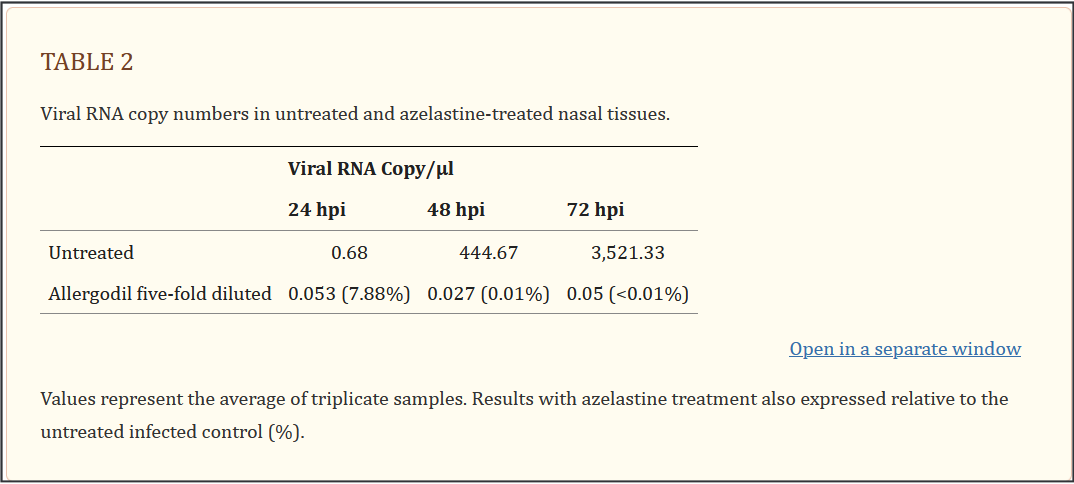Promising Way to Prevent Your Next COVID Infection
A virus called severe acute respiratory syndrome coronavirus 2 (SARS-CoV-2), which causes COVID-19 in some people, triggered one of the most significant worldwide socioeconomic upheavals of our generation.

Literature Sources
1) "Azelastine inhibits viropexis of SARS-CoV-2 spike pseudovirus by binding to SARS-CoV-2 entry receptor ACE2" (2021) by Shuai Ge and others. Link to Article.
2) "The Anti-Histamine Azelastine, Identified by Computational Drug Repurposing, Inhibits Infection by Major Variants of SARS-CoV-2 in Cell Cultures and Reconstituted Human Nasal Tissue" (2022) by Robert Konrat and others. Link to Article.
3) "Early intervention with azelastine nasal spray may reduce viral load in SARS-CoV-2 infected patients" (2023) by Jens Peter Klussmann and others. Link to Article.
A virus called severe acute respiratory syndrome coronavirus 2 (SARS-CoV-2), which causes COVID-19 in some people, triggered one of the most significant worldwide socioeconomic upheavals of our generation. Not only by the characteristics of the virus itself but by how the world responded to prevent its spread. Vaccines were quickly developed; however, their main benefit is a reduction in hospitalization, not to prevent the spread of the virus.
It may seem like the virus has gone away as policymakers put less emphasis on mask-wearing, isolation and social distancing, but SARS-CoV-2 is likely to stay with us for a long time as the virus continues to mutate, in some cases into more contagious and severe forms. This is why continued research into how to prevent the spread of the COVID-19 virus is important and why you should want to reduce your chance of ever catching COVID-19 again.
Enter Azelastine
Azelastine is a chemical used in some medications for nasal allergy symptoms. It works by inhibiting the effects of histamine on various cells in the body by binding to the receptors on the cells before histamine can. Histamine is a chemical produced by our bodies to stimulate allergic responses such as sneezing and a runny nose. By chance, azelastine binds to some of the same receptors that SARS-CoV-2 does, thus preventing the virus from entering the cell and infecting it.
In study #1, scientists confirmed this interaction and noted that cells pretreated with azelastine showed reduced viral activity. This relationship is considered concentration-dependent, meaning the higher the levels of azelastine, the less viral activity inside the cell. There is an upper limit, however, as azelastine can kill cells if there is too much of it.
This study (#1) is further supported by experiments performed in study #2. In that study, scientists in a laboratory compared two groups of cells infected with SARS-CoV-2. One was left untreated and the other was treated with an azelastine diluted liquid for 20 minutes per day. In the treated group, the amount of viral particles inside the cells was 99.9% less than in the untreated group at 48 hours after treatment began. In fact, it appears that as the virus continued to grow inside the untreated cells, its growth was stunted in the treated group.

Both studies #1 and #2 were tested on human-like cells in a laboratory and not tested on actual people. Study #3 actually carried-out an experiment on people using a randomized clinical trial. In this study, scientists aimed to see the effects of azelastine on patients who were actively infected with SARS-CoV-2. They divided patients into 3 groups: an untreated group, a group treated with 0.02% azelastine nasal spray, and a group treated with 0.1% azelastine nasal spray. In both treatment groups, patients were to spray a metered dose into each nostril three times per day.
On day 8 of the study, scientists noticed that about a fifth of the patients in the treatment groups started testing negative on COVID-19 PCR tests, while zero percent tested negative in the untreated group. In terms of symptom resolution, only the 0.1% azelastine treatment group showed modest improvement earlier than the untreated group specifically for shortness of breath symptoms. Other typical COVID-19 symptoms (lack of smell, fever, cough) improved over time regardless of treatment.
What Does This Ultimately Mean?
Based on published literature, azelastine nasal spray seems to be a promising medication that can be used to reduce the chance of getting COVID-19 symptoms and can accelerate a return to baseline after testing positive for the virus. This is, especially, a positive development for people at higher risk of getting serious complications from COVID-19 and it helps that in many countries, the medication can be bought without a prescription from a pharmacy.
While SARS-CoV-2 may be around for a long time, it doesn't mean that we will have to suffer from new variants perpetually. New medications for treatment will continue to be discovered along with advances in vaccine technology that may one day allow us to eradicate the virus.
Subscribe and Join The Discussion
Subscribe to the email newsletter and stay up to date on the latest posts from Primary Pharmacist. We want to hear your thoughts! Subscribers can also participate in discussions occurring site-wide.